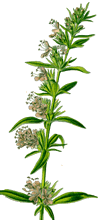
Hyssop
Psalms 51:7, 10
"Purge me with hyssop and I shall be clean; Wash me and I shall be whiter than snow. Teach me to hear joy and laughter, that the bones which thou hast broken may rejoice."
Latin name - Hyssopus officinalis
aka - Gratiola officinalis, Issopo, Yssop, Yssopo
Family - Labiatae
Parts used - flowers, young leaves
Purported actions - antiseptic, anti-spasmodic, carminative, cathartic, diaphoretic, diuretic, emetic, sedative
Methods of use - aromatic, comsetic, culinary, medicinal
Constituents - volatile oil, flavonoid, blycosies, ketones, diosmin, tannin
Origins - Hyssop is a native of southern Europe. It can be found in Asia and around the Mediterranean. The Romans are thought to have introduced it into the UK.
Description - Hyssop is an evergreen, shrubby, perenial. It grows to about 2ft (60cm) high, with long, thin, sharp-pointed leaves. It has long narrow spikes which flower from June to October and there are several varieties with blue, purple, pink or white flowers. It has a woody stem.
Attributed medicinal qualities - Hyssop is well known for its use in the treatment of colds and congestion. In America it is also used externally for the relief of muscular rheumatism, and for bruises and discoloured contusions, in addtion the green herb when bruised and applied is said to heal cuts promptly. It has also been used to treat Karposi's sarcoma found in more advanced stages of HIV infection and is purported to strengthen the immune system.
History - The name hyssop can be traced back almost unchanged through the Greek hyssopos and Hebrew esob meaning 'holy herb.' It is uncertain that Hyssopus officinalis is the same 'hyssop' referred to in the scriptures Scriptures (1 Kings 4.33; Ps. 51.7; John 19.29), however it was once regarded as a symbol of purification and as such was used in the ritual cleansing of churches, it was often planted in monastery gardens and was used in religious painting to symbolize humility.
Because of its bushy nature it was often used as a hedge in herb gardens and even in mazes. In the seventeenth century, it was used as a strewing herb in sick rooms, to deter the spread of infection and to cleanse lepers, as noted in the scriptures.
For centuries it was used as a medicinal herb against coughs and catarrh. And it was part of an old English country remedy for cuts and wounds suffered working in the fields where a poultice of bruised hyssop leaves and sugar was used in order to reduce the risk of tetanus infection. Where Hyssop was at one time official in some pharmacopoeias of Europe it is now grown mostly as an ornamental shrub.
Cultivation - Hyssop is relatively easy to grow and well worth while as it is a pretty addition to any garden with a strong aroma. It prefers a sunny spot in well drained soil, but can tolerate some shade. It can be grown from seed or cuttings. Plant seeds in the spring or take cuttings during the summer. It flowers from mid to late summer.
Harvesting, preparation and storage - You can pick the young leaves at any time of year, and they can be preserved by drying. For medicinal purposes they should be harvested on a dry day at the peak of their maturity and the concentration of active ingredients is highest. They should be dried quickly, away from bright sunlight in order to preserve their aromatic ingredients and prevent oxidation of other chemicals.
Hyssop leaves should dry out in about six days, any longer and they will begin to discolour and lose their flavour.
The dried leaves can be stored in clean, dry, airtight containers, and will keep for 12-18 months.
The flowering tops of Hyssop should be collected in August. They can be used fresh or dried in the sun.
Culinary Uses - Hyssop has a slightly bitter minty flavour. The leaves can be sprinkled sparingly over salads or added to apple stews, pies or flans. A few leaves can be used in savoury dishes such as rich stews and in marinades. The flowers can be used as an attractive garnish and in salads.
Do not use both the leaves and flowers to flavour the same dish as the stronger flavour of the leaves dominates that of the delicate flowers, which can be added just as decoration.
Recipe - Carrot and Hyssop salad
Magical Uses - Hyssop is a purifying herb. It can be used to sweep sacred spaces and added to water, infused and sprinkled sparingly over objects to cleanse them. Scattering the plant or hanging it in the house at windows or doors it can cleanse and protect from harmful energies.
- It attracts bees and butterflies.
- It is used in the manufacture of the liquers Absinthe, Chartreuse and Benedictine.
- It is a nice addition to potpourri.
- It is said to repel flea beetles and lure away cabbage moths.
- It can be used in soothing herbal baths.
- The essential oil has been used in perfumes, colognes, soaps, creams and other cosmetics.
Culpeper: "It strengthens all the parts of the body under Cancer and Jupiter; which what they may be, is found amply described in my astrological judgment of diseases."
Dioscorides: " Hyssop boiled with rue and honey, and drank, helps those that are troubled with coughs, shortness of breath, wheezing and rheumatic distillation upon the lungs."
Gerard: - "Hyssope made with figges, water, honey and rue and drunken, helpeth the old cough."